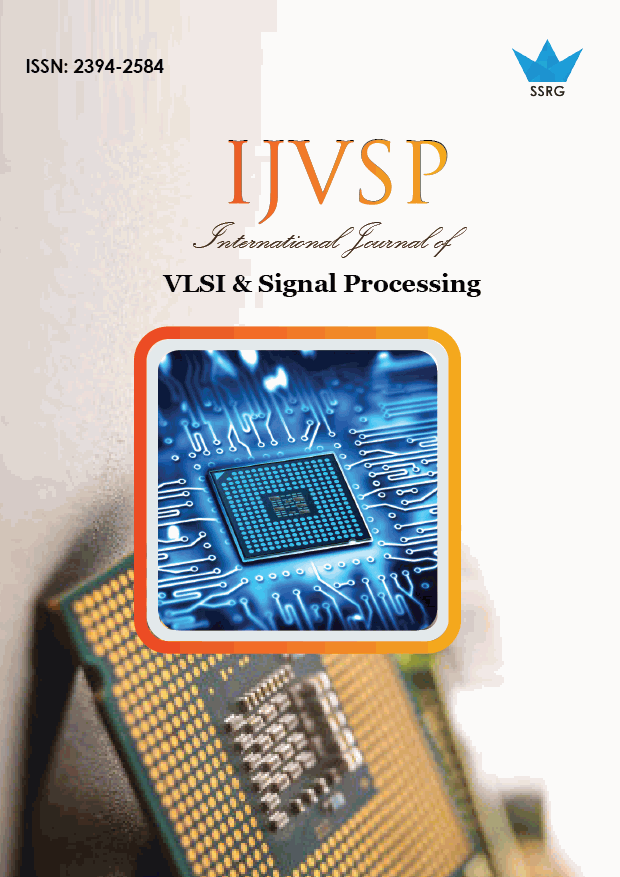Optimizing the Modified Booth Recoder for Fused Add-Multiply Operator

| International Journal of VLSI & Signal Processing |
| © 2015 by SSRG - IJVSP Journal |
| Volume 2 Issue 2 |
| Year of Publication : 2015 |
| Authors : Manju Mallayagari and G. Sahithi Reddy |
How to Cite?
Manju Mallayagari and G. Sahithi Reddy, "Optimizing the Modified Booth Recoder for Fused Add-Multiply Operator," SSRG International Journal of VLSI & Signal Processing, vol. 2, no. 2, pp. 1-5, 2015. Crossref, https://doi.org/10.14445/23942584/IJVSP-V2I2P101
Abstract:
This proposed method the design and simulation of Radix-8 Booth Encoding that can employ in DSP applications. As the Radix-8 Booth Encoder circuit produces n/3 the partial products in parallel manner. The proposed scheme effectively implements a newly recoding technique for modified booth recoding that ensures to implement the direct recoding of the multiplier in its Sum Modified Booth (SMB) form. Another vital advantage of S-MB algorithm that is well structured, simple and can be easily modified in order to apply either in signed or unsigned numbers, which consists of odd or even number of bits. Also Carry Save Adder (CSA) tree and the final Carry Look ahead (CLA) adder used to speed up the multiplier operation. Because of signed and unsigned multiplication operation is well performed by the same multiplier unit the required hardware and thus chip area reduces and this in turn reduces power dissipation and cost of a system. Finally Fused Add Multiply operator is optimized to increase the performance of complex arithmetic operation with three different recoding schemes S-MB1, S-MB2, S-MB3.The simulation is done through Verilog on xiling13.3 platform which provide accurate in calculating the various parameters.
Keywords:
Array multiplier, Fused Add Multiply, Braun array multiplier, CLA, CSA, Radix-8 Booth Encoding multiplier, Signed-unsigned.
References:
[1] A. Amaricai, M. Vladutiu, and O. Boncalo, “Design issues and implementations for floating-point divide-add fused,” IEEE Trans. Circuits Syst. II–Exp. Briefs, vol. 57, no. 4, pp. 295–299, Apr. 2010.
[2] E. E. Swartzlander and H. H. M. Saleh, “FFT implementation with fused floating-point operations,” IEEE Trans. Comput., vol. 61, no. 2, pp. 284–288, Feb. 2012.
[3] J. J. F. Cavanagh, Digital Computer Arithmetic. New York: McGraw Hill, 1984.
[4] S. Nikolaidis, E. Karaolis, and E. D. Kyriakis-Bitzaros, “Estimation of signal transition activity in FIR filters implemented by a MAC architecture,” IEEE Trans. Comput.-Aided Des.Integr. Circuits Syst., vol.19, no. 1, pp. 164–169, Jan. 2000.
[5] An Optimized Modified Booth Recoder for Efficient Design of the Add-Multiply Operator Kostas Tsoumanis, Student Member, IEEE, Sotiris Xydis, Constantinos Efstathiou, Nikos Moschopoulos, and Kiamal Pekmestzia IEEE transactions on circuits and systems: regular papers, vol. 61, no. 4, April 2014.
[6] E. E. Swartz lander and H. H. M. Saleh, “FFT implementation with fused floating-point operations,” IEEE Trans. Comput., vol. 61, no. 2, pp. 284–288, Feb. 2012.
[7] Y.-H. Seo and D.-W. Kim, “A new VLSI architecture of parallel multiplier–accumulator based on Radix-2 modified Booth algorithm,” IEEE Trans. Very Large Scale Integr. (VLSI) Syst., vol. 18, no. 2, pp.201–208, Feb. 2010.
.

 10.14445/23942584/IJVSP-V2I2P101
10.14445/23942584/IJVSP-V2I2P101